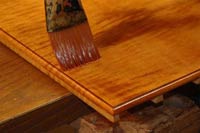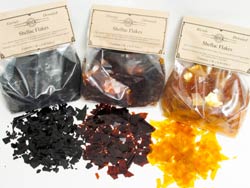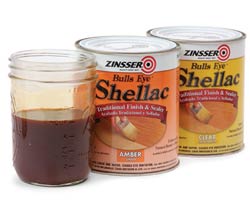Small Home Gazette, Spring 2011
Getting Shellacked

Bob Yapp is a furniture maker, old house restorer, author, teacher, preservation consultant and hosted the national PBS series “About Your House with Bob Yapp.” Yapp lives in Hannibal, Missouri, where he runs The Belvedere School for Hands-On Preservation.
For over 2,000 years, shellac was a product of choice for dyes, flooring, woodwork, furniture and as a sealer. Its use as a wood finish flourished in America from the 1600s through the first half of the 20th century. The qualities making it so popular were (and are) ease of application, fast drying time, ease of repair, fast clean-up, high durability, color control, and its ability to bring out the beauty of wood better than most finishes available today.

Toward the end of the first half of the 20th century, shellac fell on hard times. Most contractors and homeowners switched to petroleum based varnishes, lacquers and urethanes primarily as a result of misinformation. It was said that shellac showed water rings from glasses, was not alcohol resistant, darkened with age, and tended to craze or alligator. Some of these claims were based on fact but most were not.
While it’s true that shellac is not alcohol or water ring resistant, damage caused by either is easily repaired. If someone leaves a sweaty glass of water on a shellac surface, the white ring can be buffed out with a little lemon oil and #0000 steel wool. This issue only applies to horizontal surfaces like tabletops. Unlike petroleum based finishes, nicks, scratches and alcohol marring in shellac can be repaired by adding more shellac to the damaged area and buffing with #0000 steel wool as well.
The good news is, shellac is seeing resurgence in popularity. The green revolution in construction may be one reason for shellac’s rise in use. While I believe this is important, let’s not forget that preservation-oriented, rehabilitation of historic properties is one of the greenest activities in the construction industry. Rehabbing old houses and utilizing original materials is essentially the definition of recycling.
 So, what makes shellac such a green product?
So, what makes shellac such a green product?
- It’s the only finish on the market that is all natural as well as a renewable resource. Shellac is based on the hard resin shells the lac bug creates on trees in India and Thailand. This is processed into flakes and added to denatured alcohol that comes from crop plants, not oil.
- Shellac is alcohol-based and meets all federal and state regulations in regard to air quality standards.
- Cured shellac is non-toxic and safe even on chewable surfaces that kids can reach.
You can tell if your finish is shellac by putting a small amount of denatured alcohol on a rag and wiping an area that is out of the way. If the finish dissolves then you know its shellac. If it’s in good shape and just needs cleaning use mild liquid soap, diluted in warm water. Ring the rag out very well before wiping down the shellac surface. Do not use any so-called “oil soaps” on shellac surfaces. One of the main ingredients in oil soap is alcohol and so it can ruin the finish.
If the shellac surface is “alligatored” (small cracks throughout the finish), it can be repaired. Pour some denatured alcohol into a small can or plastic bucket. Buy a natural bristled brush rated for oil paints and finishes. Dip the brush into the alcohol and let most of the alcohol drip out of the bristles. Now, take the brush and flow it over the shellac surface. The alcohol will melt the surface of the finish causing the alligatored finish to smooth back out again. Once the old shellac has been restored to a smooth consistency you can go back over it with clear shellac. The finish will look authentic but completely rejuvenated.
Shellac also is very easy to strip. Soak the area you want to strip with denatured alcohol, let it sit for about 30 seconds and rub the area of softened finish with one of those green, medium grade scouring pads. Denatured alcohol can be purchased by the gallon for half the cost of toxic strippers at most paint or hardware stores.
 Shellac comes in two different varieties—amber and clear. Amber is the natural color of shellac and clear, or white, is bleached for a clearer finish. The more amber you apply, the darker the finish will become. Applying amber until you like the color and then adding clear shellac over it as a topcoat can control this. You can buy shellac in pre-mixed cans with a shelf life of about three years.
Shellac comes in two different varieties—amber and clear. Amber is the natural color of shellac and clear, or white, is bleached for a clearer finish. The more amber you apply, the darker the finish will become. Applying amber until you like the color and then adding clear shellac over it as a topcoat can control this. You can buy shellac in pre-mixed cans with a shelf life of about three years.
Shellac is the finish of choice for just about all my projects. Don’t forget, lac bugs are like lemmings—they create larva, cover them with resin, and then give their lives to become the finish on your woodwork.
Editor’s note: As with any product you’ve never used before, practice your technique before starting an important project.











